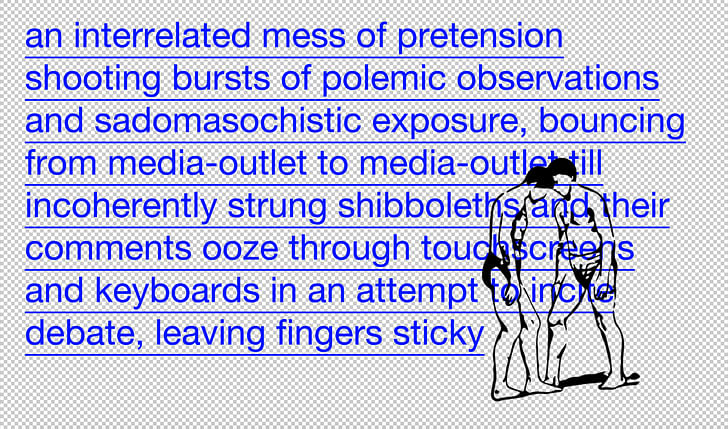

A(nta)gonistic—a fragile web composed of the agonist, antagonist, and anti-agonist—is how the contemporary struggle unfolds in architectural discourse: an interrelated mess of pretension shooting bursts of polemic observations and sadomasochistic exposure, bouncing from media-outlet to media-outlet till incoherently strung shibboleths and their comments ooze through touchscreens and keyboards in an attempt to incite debate, leaving fingers sticky.
My personal inner a(nta)gonist feeds on a concern with such performances in today’s disciplinary rhetoric. Sometimes I just don’t feel like it, feel like coming face to façade with self-serving dramaturgies being sold as a consciously reflected line of critical inquiry. Sure, the struggle is real and worthy of debate, but what struggle are we talking about here? It seems like there exists a never-ending loss-in-translation, an apathy that assumes subjective positions in subduing its agonistic ‘other’ through open debate and self-promotion rather than well-formulated rebuttals. One has to be careful not to donate too much attention to the a(nta)gonist, whose agonic feats may have already slipped into an intellectually charged autoeroticism that is less productive for the discipline than conducive of an all-encompassing advertising strategy (*not adversarial but advertorial).
Who knows though—it could just be me. I have never felt comfortable with this sort of distorting enactment of disciplinary agency that claims to speak for an obscure group of like-minded individuals, voices of the many imploding into fragmented remarks of said one charismatic a(nta)gonistic figure. If (recent) history has taught us one thing, this just never ends well. The exclamation collapses in on itself and a question emerges: What is the panacea for this detached participation where I can chime in on global debates without stepping outside of the singularity of my apartment?As much as this struggle is fake and forced, it may bring us closer to a realization that architectural discourse should not operate on that level of theatricality
Maybe this is something that could be remedied with critical pedagogical processes that subsume the show of intention and mutate its consternation into constructive dialog. Rather than boasting the exploration of mediated (prot)agonists, we should embrace the pedagogical from the outset, doing away with the role of the a(nta)gonistic and replacing it with the principle of critical agonism—as it should and needs to become an integral part of all our practice(s) and teaching(s). After all, the agonist not only binds but also activates the ‘other’ in this dialogic constellation that sways between the rather inhibiting properties of the antagonist and the inverting characteristics of the anti-agonist.
Activation should equally not lead to dependency; agonists may switch and swap their ‘others’ in order to progress discussions and the discipline. Who wants to see the same (prot)agonists battling it out in obscurely-titled symposia held in esteemed institutions that feel obliged to provide a dramaturgic intellectual scenery for the pseudo-operative fight?!
As much as this struggle is fake and forced, it may bring us closer to a realization that architectural discourse should not operate on that level of theatricality. We need to break off from the behavioral patterns that have invaded every dialogic occurrence from politics to art, from music to film, and from cat memes to dancing poodles. Modify!
Cross-Talk is a new recurring series on Archinect that endeavors to bring architectural polemics and debate up-to-date and up-to-speed with the pace of cultural production today. Each installation will feature four responses by four writers to a single topic. For this week's iteration, the topic is 'agonism', a political theory that has begun to enter the architect's lexicon. Championed, in particular, by the political theorist Chantal Mouffe, 'agonism' asserts that productive conflict, rather than consensus, produces democracy.
Clemens Finkelstein is a historian and theorist of art and architecture. He is a doctoral student in the History and Theory of Architecture at Princeton University, a graduate of the History and Philosophy of Design program at Harvard University, and has worked extensively as a writer ...
No Comments
Block this user
Are you sure you want to block this user and hide all related comments throughout the site?
Archinect
This is your first comment on Archinect. Your comment will be visible once approved.